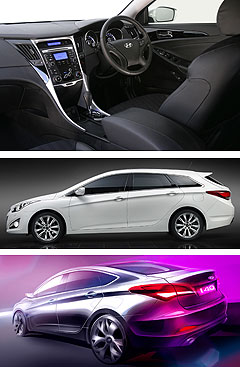New models - Hyundai - i45 - 2.0-litreHyundai lowers i45 entry pointBase price cut: The new 2.0-litre Hyundai i45 sedan replaces the 2.4-litre Active variant (pictured) as the entry-level model in the Korean brand's mid-sized range. Cheaper 2.0-litre version cuts base price of Hyundai’s i45 sedan to $26,9909 May 2011 HYUNDAI has lowered the entry price of its i45 medium sedan by $2600 to just $26,990 with the introduction of a new 2.0-litre range opener. Replacing the manual version of the former entry-level 2.4-litre Active sedan, with which the newcomer shares its standard equipment, the new i45 2.0 Active is now also on sale in automatic form ($28,590). Hyundai is currently offering the i45 2.0 MPI automatic at a drive-away price of $29,490 including on-road costs, with the i45 2.4 GDI automatic at $30,990 drive-away. The new i45 2.0 MPI manual’s sub-$27,000 list price is lower than the previous-generation Sonata’s $27,990 base price and makes the i45 Australia’s most affordable mid-size sedan after Skoda’s 1.4-litre Octavia 90TSI ($24,990). The i45 now undercuts Holden’s aged Epica 2.5 (from $28,490), which is also built in Korea and will be replaced by the all-new Malibu sedan in the second half of next year, as well as the Suzuki Kizashi 2.4 (also from $28,490), the evergreen Mazda6 (from $27,310) and Toyota’s soon-to-be-replaced top-seller, the Australian-made Camry (from $30,490). Hyundai chose not to release the i45 with its 2.0-litre MPI engine, which produces 121kW at 6200rpm and 198Nm of torque at 4600rpm, when the all-new mid-sizer replaced the previous Sonata sedan in Australia in May 2010.  From top: Hyundai i45 2.4 Active interior, Hyundai i40 wagon and i40 sedan sketch. From top: Hyundai i45 2.4 Active interior, Hyundai i40 wagon and i40 sedan sketch.At the time, the i45 was launched exclusively with a direct-injection four-cylinder petrol engine delivering 148kW/250Nm and returning ADR81/02 fuel consumption of 7.9L/100km in six-speed automatic form. For the record, the port-injection 2.0-litre i45 sedan returns the same 7.9L/100km with a six-speed manual but increases the model’s efficiency to 7.6L/100km with a six-speed auto. While the six-speed automatic is identical in both models, the 2.0-litre engine is matched with shorter final-drive ratios, with the manual version also featuring revised internal gear ratios. In automatic form, the 2.0-litre model’s kerb weight is 32kg lower at 1496kg, while the base i45 2.0 manual weighs 1479kg. All 2.0-litre models come with slightly smaller brake discs, measuring 280mm at the front (down from 300mm) and 262mm at the rear (down from 284mm), but electronic stability control and four-channel ABS brakes with EBD remain standard. All other specifications are carried over from the i45 Active 2.4, including its maximum 1300kg braked towing capacity (650kg unbraked). Last year Hyundai sold 2038 examples of the i45, an upgraded MY11 version of which was launched in response to media criticism of the original model’s steering and ride quality, representing a little over half of its 4000 sales target for 2010. The i45 recorded its best monthly sales figure of 405 last month, when it was Australia’s third-best-selling mid-size vehicle under $60,000 with a 7.1 per cent share of the segment. However, with 1381 sold in the first four months of this year, equating to a monthly average of 345, Hyundai’s newest mid-sizer remains well short of its 500/month sales target. The cut-price 2.0-litre Active should bolster total sales of the i45, in line with Hyundai’s launch forecast of increasing the i45’s fleet sales component from 30 to 50 per cent over the course of its model life. The sedan-only i45 will be joined in Australia by the i40 wagon in November and possibly by the similarly Euro-centric i40 sedan next year, potentially giving Hyundai a three-pronged mid-size model attack, and finally with diesel power.  Read more4th of November 2010  First drive: Hyundai claims i45 hybrid high groundHyundai says its i45/Sonata hybrid is superior in every way to Toyota’s hybrid Camry11th of October 2010  Hyundai tweaks i45Hyundai Australia meets media criticism of new i45 inside six months |
|
















Facebook Twitter Instagram